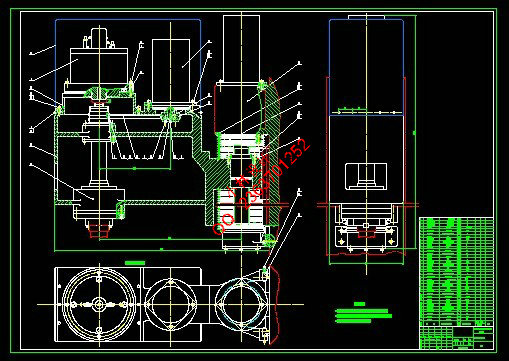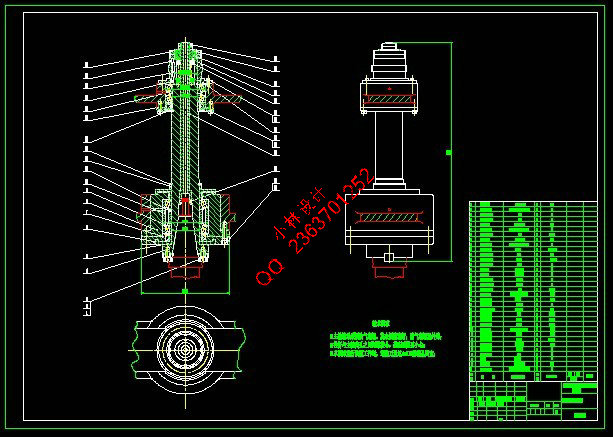|
设计简介 |
设计描述:
文档包括:
word说明书一份,共60页,约20000字
CAD版本图纸,共4张
摘 要
在传统的立式钻床、铣床与新型数控机床技术的基础上,开发了以钻削为主,并兼有攻丝、铣削等功能,且备有刀库并能够自动更换刀具来对工件进行多工序加工的数控机床—钻削中心。本文主要针对钻削中心的主轴系统进行设计。在本设计中,主轴调速取消了齿轮变速机构,而是由交流电动机来调速;主轴与电机轴之间采用多楔带传动;主轴内部刀具的自动夹紧,则采用了碟形弹簧与气压传动技术;主轴的垂直进给采用了半闭环伺服进给系统;主轴的支承采用了适应高刚度要求的轴承配置。总之,通过对主轴系统的设计,使系统满足了钻削中心高效、高加工精度的要求。
关键词:数控技术;钻削中心;主轴系统
Abstract
In the traditional vertical drilling machine, CNC milling machine and new technology on the basis of developing a drilling mainly, and both tapping, milling, and other functions, With cutting tool can automatically replace the multi-process workpiece machining CNC machine tools – Drilling Center.This paper is concerned with the drilling spindle system design. In this design, the spindle speed of the complete elimination of the variable speed gear, and a fully by the AC motor is to be achieved. Wedge Belt Drive is used between spindle and motor shaft. Internal spindle automatic tool clamping, the use of a disc spring with pressure transmission technology;The vertical axis feed using a semi-closed-loop servo control system; The supporting of spindle uses high stiffness requirements of the bearing arrangement. In short, through the spindle system design, allowing the system to meet the drilling center efficient, high-precision processing of the request.
Keywords:NC technology ;Drilling Center ;Spindle system
目 录
摘 要 I
Abstract II
第1章 绪论 1
1.1 数控机床的概念 1
1.2 数控机床的组成 1
1.3 数控技术发展状况及发展趋势 1
1.4 设计的目的与意义 4
第2章 总体设计方案的确定 5
2.1 设计方案 5
2.2 方案的可行性分析 6
2.2.1 钻销中心的设计特点 6
2.2.2 本设计的创新之处 7
第3章 钻削中心主轴部件结构设计 8
3.1 主轴的结构设计 8
3.1.1 主轴的基本尺寸参数的确定 8
3.1.2 主轴端部结构 9
3.1.3 主轴刀具自动夹紧机构 10
3.1.4 主轴的验算 12
3.1.5 主轴材料和热处理的选择 16
3.2 主轴传动部件的设计 17
3.2.1 传动方式的选择 17
3.2.2 多楔带带轮的设计计算 18
3.2.3 多楔带的选择及带轮尺寸参数的确定 20
3.2.4 传动带在主轴上的位置 22
3.3 主轴轴承 23
3.3.1 主轴轴承的选用 23
3.3.2 主轴轴承的配置 25
3.3.3 滚动轴承调整和预紧方法 26
3.3.4 主轴轴承的润滑 27
3.4 碟形弹簧的设计 29
3.4.1 钻削力分析 29
3.4.2 碟形弹簧设计计算 30
3.4.3 碟形弹簧的校核 33
3.5 气缸的设计 35
3.5.1 气缸的结构设计 35
3.5.2 气动回路选择 38
第4章 主轴进给系统的设计 41
4.1 概述 41
4.1.1 伺服进给系统的组成 41
4.1.2 伺服进给系统的类型 41
4.2 进给系统设计计算 43
4.2.1 主要参数的设定 43
4.2.2 切削力的估算 43
4.2.3 滚珠丝杠副设计计算 43
4.2.4 丝杠的校核 46
4.2.5 选伺服系统和检测装置 49
4.2.6 伺服电机选择 49
结 论 51
致 谢 52
参考文献 53
|









